Bob Brown discusses the events that occurred during the Franklin River campaign as depicted in his portrait by Harold 'The Kangaroo' Thornton.
This video was produced with funds donated by Tim Fairfax AC.
Bob Brown discusses the events that occurred during the Franklin River campaign as depicted in his portrait by Harold 'The Kangaroo' Thornton.
This video was produced with funds donated by Tim Fairfax AC.
This is 1982 through 1983 over that Christmas period. The blockade started on the thirteenth of December and I was arrested on the 16th spent Christmas in jail and came back out with and overall 6,000 people came down to the little village of Strahan on the west coast of Tasmania to go and join the blockade. 1600 were arrested and 500 were jailed and the charge was 'lurking or loitering in the forest' it had been a manufactured law brought hurriedly by the Premier of the State Robin Gray who was called the whispering bulldozer he got elected in May 1982 and within two months the bulldozers rolled into the Franklin Valley. That's him up there and just behind him was a little man who's puppeteering the premier that's the head of the hydroelectric commission commissioner Russell Ashton the Hydroelectric Commission ran Tasmania and its economy and its future in those days and across over on the other side's Joh Bjelke-Petersen the Premier of Queensland after whom Robert Gray patented himself he came down to support the building of the dam and afterwards spent a lot of time saying to me I shouldn't go to Queensland when I was helping campaign to protect the Daintree forests and the Barrier Reef to interfere in Queensland affairs.
Up there is a High Court judge next to the HEC building which is the judge knocking on the door effectively because this was painted before the decision by the High Court to save the Franklin so the judge is about to hold judgement over the Hydroelectric Commission the f-111 fighter planes are really interesting they used to come down and fly over the jagged terrain the Tasman wilderness for practice but the High Court case was coming and the New Commonwealth Government needed to get direct evidence that the dam was being built photographic evidence new Attorney General Gareth Evans decided he would get the Air Force planes as part of their exercise to take pictures of the dam to get evidence. It led to a national furore. The Constitution says that the Armed Services will never be used against the State but Gareth Evans made that decision and he got called Biggles afterwards and they also used the famous what was called the streakers lament or excuse it seemed like a good idea at the time. Streakers being of course the folk who run occasionally naked into the middle of a football ground.
And over in that corner is the people for the dam and they got banners including take your Brown leeches with you that comes out of a the most famous statement that the whole dams campaign Robin Gray saying the Franklin is nothing but a brown leech- ridden ditch and when he said that he people had seen this beautiful river on their television screens have been lots of pictures go out and they knew that he was he just didn't get it when it came to beautiful wild places full of wildlife while talking about life in wild places here Harold Thornton who was this eccentric character who grew up on Sydney went to Amsterdam at the height of the flower power of the 1960s and came to Tasmania I don't know whether he was attracted by the dam campaign I suspect so and then painted this portrait in the wake of the blockade but before the High Court decision there's a little portrait of him in the forest he's painted himself over there looks like the spoon that run away with the dish here's a man's imagination which has lifted himself up out of the forest in the style of many pre-photographic drawings of cities around the world it has to been turned into somewhat of a cartoon or a caricature but that's telling the story. It was Harold's way of being able to tell a story as he saw it and he's added humour to what was a very desperate situation down there. It sort of fits the eccentric colorful character that Harold Thornton was that he he took this view which seems nobody else would think it up but now tells us a story in such a dramatic but very careful way. There was not a story there's a hundred stories in in this picture that's what's so good about it.
Now he's painted myself three times in this picture each time with a question mark in front and that's probably because I was always philosophical about where the world going to if we destroy this if we can't save this how can we ask people in poorer countries decide their rivers their forests their wildlife but I was very embarrassed by this picture look it's got what looks like a halo around it and I know better than that but he painted it and I've got accommodated to it now I don't care. The good thing about it is when you look into the trees there's seems like there's hundreds of people in there; well they were. The whole operation upriver was a huge planning exercise over 50 people came from Western Australia for example to the blockade there were people there from Britain and Germany and all states and territories a lot of people from here in the ACT and they risked they thought losing their passports if they're arrested maybe losing their jobs if they're in the public service certainly getting a reputation a criminal record so they're putting a lot on the line there's a policeman here chasing little green figures little greenies through the forest but over there behind me is another police officer's put her or his cap on the ground and inside is No Dam, a little No Dam sticker because a lot of the police were wanting to save the river as well but they had to go down there and carry out the orders to arrest the Greenies.
There's a interesting little section behind the police officer there about the practicalities - wash your hands after you've been to the toilet - make sure you put some lime in the pit. A lot of people living in a wild environment you had to stop an outbreak of disease. Big job to feed all those people and over on that side of the picture is the Denison star the human pine boat made by Ulrich Morrison had been a pioneer up in these rivers in his young days coming upriver with the tourists and in the middle of the pictures of the Daily M there I went and saw Reg at the racecourse in Hobart in the year leading up to this and said Reg we're going to be beaten here can you transport people upriver to protest in the forest and I thought he'd say no because he had built up a huge reputation for his cruisers worldwide but he said yes I'll bring the old cruise boat back in Denny Hamel who is also in this picture brought that boat up and down river more than a thousand people were brought up with or thousands when you take into account journalists also brought up on chart cats we got the abalone divers it was offseason to use their very fast motor boats to bring journalists each morning across Macquarie Harbour 20 kilometres up the river and another 20 kilometres they had to get back in those days by two o'clock so that their film could be flown out worldwide attention was focused on the Franklin and from Britain came television personality and self-described pommy botanist professor David Bellamy - that's him that face in the tree there and he was arrested on the Franklin and taken to Risdon Jail where he had his 50th birthday that was headlines all over the world and particularly in Britain so it really made this blockade a matter of international attention and he, like so many other people who I've met since, reckon being in this blockade was one of the best times of their lives It was a sense of comradery which was very very important because beneath all that people were quite frightened about facing the anger of hydro workers who'd been who'd been stirred up Robin Gray who had told one fellow he was working on a bridge to the Bayonne Bridge in Hobart well he been out to visit the workers he'd said he wouldn't mind giving them all baseball bats to go and deal with the Greenies over in the west coast and famously he turned up at a rally in the nearby town of Queenstown with boxing gloves on to take on the Greenies so the message being sent to the people opposed to the dam was you can get stuck into these people and it did lead to violence it led to people being assaulted and including yours truly like one night I had four men come at me with a tyre lever and I forgot my non-violent training and somehow or other I ended up at the tyre lever and the four men running but that's self-preservation at work for you but people did get beaten up and windows in the Wilderness Society buildings were smashed and there was a fair deal of tension and fear about Young folk were out in their rubber duckies getting in front of this machinery some of them were diving underneath but they're all being arrested it stayed peaceful all the way - it was a violent invasion of these forests and the wildlife but the strength of this protest was it stayed peaceful and while ever it did there was a gathering feeling of support for it by the people of Australia and in March just as this blockade was tailing off they changed the government.
The Hawke Government came in it decided it was going to oppose Robin Gray and his dam building. That went through the High Court the judges up there and by four judges to three on the first of July 1983 effectively made the decision the damn must stop the wilderness must be saved for the whole of the world according to the World Heritage convention so when this was painted it looked very green but now I've got a smile on my face because what Harold depicted there was a huge peaceful protest with people from all over Australia which ended up saving the river.

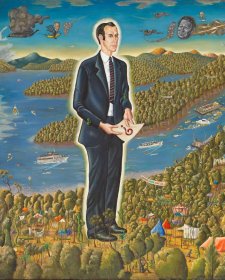
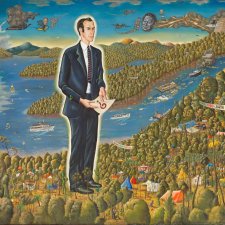
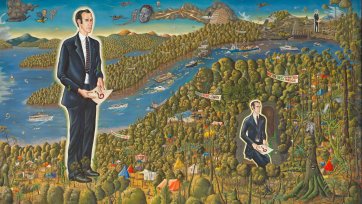
Michael Desmond explores the complex portrait of Dr Bob Brown by Harold 'The Kangaroo' Thornton.
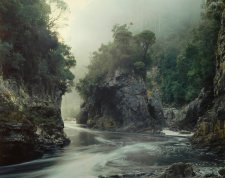
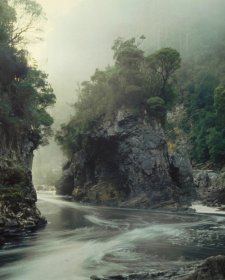


Olegas Truchanas and Peter Dombrovskis, photographers and conservationists, shared a love of photography and exploring wilderness areas of Tasmania.



Drop into the Gallery any time for free creative activities inspired by artist Thom Roberts and his exhibition, The Immersive World of Thom Roberts.